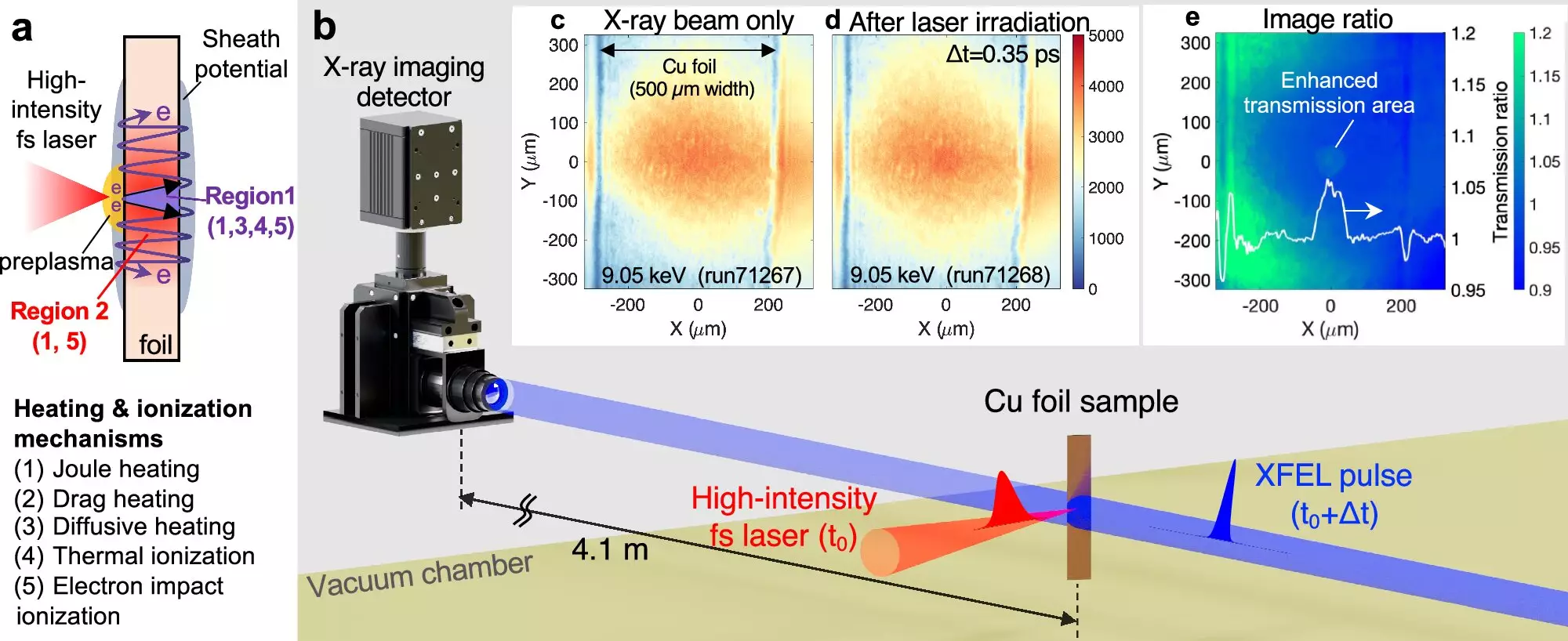In a rapid sequence of events measured in picoseconds, a remarkable transformation occurs when a small piece of copper encounters an intense laser pulse. This seemingly mundane metal undergoes a spectacular metamorphosis, transitioning from a solid state to a dense plasma phase known as warm dense matter—a term that only hints at the more than 200,000 degrees Fahrenheit that the metal reaches in this blink of an eye. This phenomenon, where copper becomes a state of matter that occupies the fascinating middle ground between solid and plasma, is of great interest to physicists studying conditions similar to those found in the interiors of giant celestial bodies and within the high-energy environments of laser fusion reactions.
Researchers, led by Hiroshi Sawada from the University of Nevada, Reno, are pioneering new methods to analyze the intricate dynamics of heat transfer and phase transitions in materials subjected to laser pulses. The research team’s recent publication in *Nature Communications* details innovative techniques developed in cooperation with several international facilities designed to examine how materials heat up and cool down under these extreme conditions.
The sequential approach used by the researchers, often referred to as a pump-probe experiment, plays a crucial role in unpacking the drama of heating and cooling in copper. The initial ‘pump’ phase involves a relativistic intensity laser pulse that rapidly elevates the temperature of the copper—triggering the transition to plasma. Following this explosive response, a secondary ultra-short X-ray pulse, or ‘probe,’ captures images of the copper, allowing scientists to observe and document changes in temperature and the ionization degree of the material over time.
The precision and speed of these techniques are of paramount importance, especially due to the lightning-fast nature of thermal dynamics at such scales. Each experiment offers crucial data about the progression of heat as it travels through the material, effectively freezing-in-time various stages of the reaction. The X-ray Free Electron Laser (XFEL) utilized in these experiments, located at the SPring-8 facility in Japan, offers critical capabilities that have positioned it as one of the foremost research centers worldwide, alongside a select few others such as the Linac Coherent Light Source in the U.S. and the European XFEL in Germany.
Despite the robustness of numerical simulations guiding their expectations, the research team was astounded by the actual results witnessed. Rather than transitioning to a classical plasma state as anticipated, the copper exhibited characteristics indicative of warm dense matter. This unexpected revelation prompts a re-evaluation of prevailing understandings regarding material behavior in high-energy environments.
The insights provided by these collaborative experiments pave the way for advances across numerous fields of physics. The implications extend well beyond understanding the interaction of lasers and materials; they also touch upon astrophysics, high-energy-density research, and inertial fusion energy. By demonstrating that significant atomic-level changes can be captured with unprecedented precision, the experimental approach offers a rich soil for exploration into almost all types of matters subjected to extreme conditions.
With XFELs playing a vital role across a variety of scientific disciplines—including chemical engineering, biochemistry, and physics—the research is particularly timely. The pressing need for improved methodologies in diagnosing warm dense matter and understanding the nuances of heat transfer in dense materials stems from both fundamental science and practical applications. As scientists continue to push the limits of laser capabilities, the tools developed can be applied at other facilities such as the upcoming MEC-U at SLAC, thereby broadening the scope of this research.
The innovative approach described by Sawada and his colleagues represents a significant leap forward in the capability to understand material transformations under extreme conditions. This work not only clarifies existing theories about plasma formation but also opens new avenues of research regarding heat dynamics at the microscale. As the scientific community delves deeper into these phenomena, the knowledge generated will support advancements that may one day extend to practical applications in various technologies and natural phenomena alike.


Leave a Reply